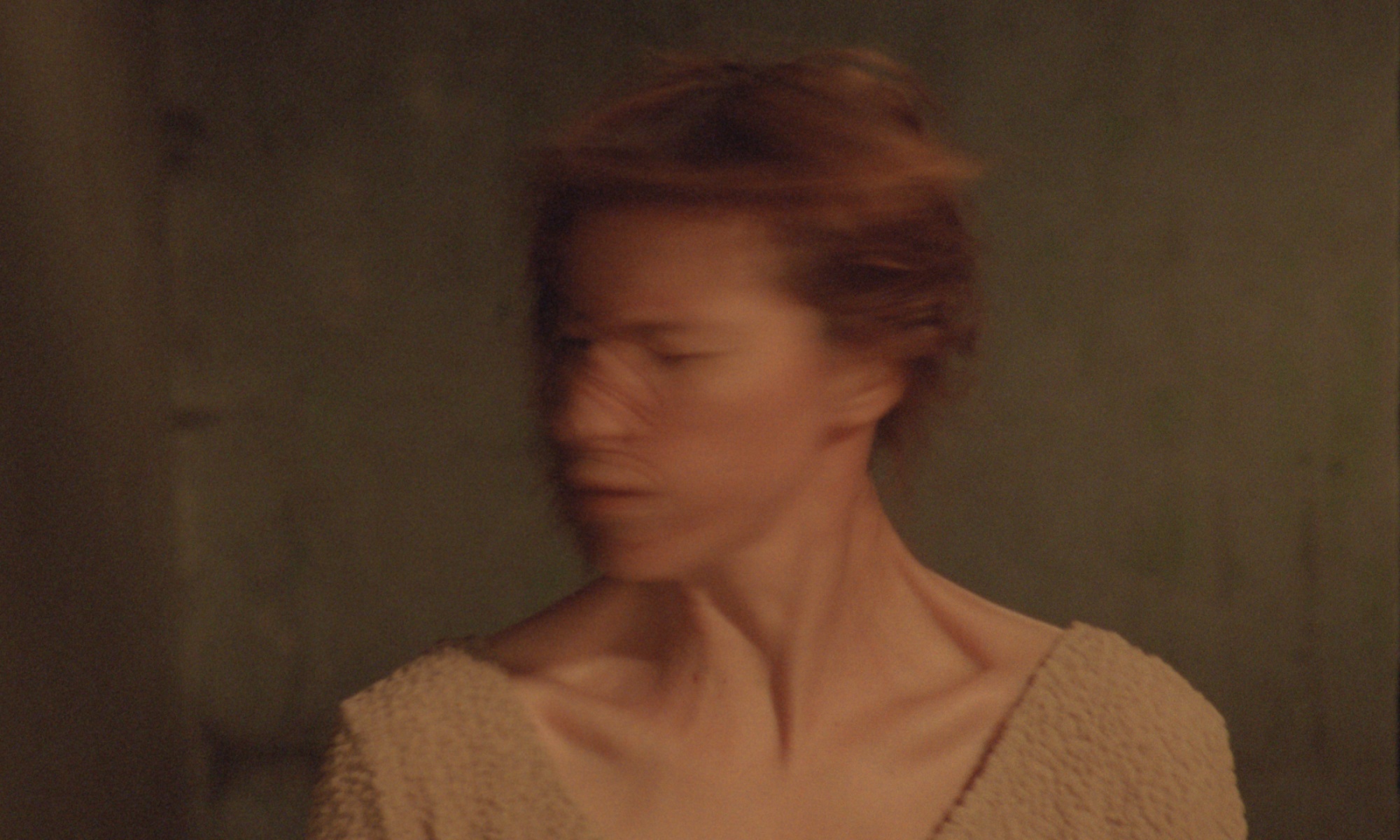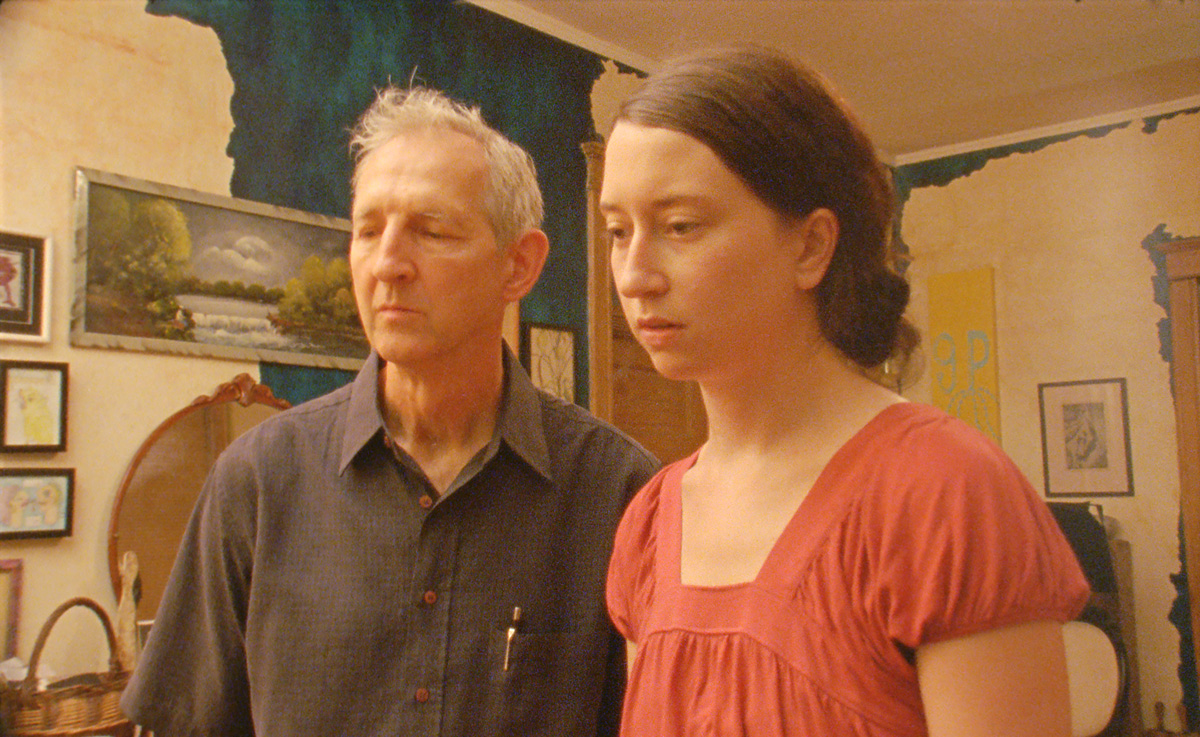In four short films, projected simultaneously in the exhibition space, Melika Bass offers four portraits of sorts. Each film centers on a single character during an extended contemplative moment: a man sits by himself in the passenger seat of his car, listening to recordings of a sermon. Another man works in his wood shop and then writes a homily of his own, speaking it aloud. In a third film, a young woman cleans herself in a church bathroom before singing a hymn at the front of an empty sanctuary. This same young woman appears in the last enigmatic film, too, crouching under a bush and washing her hands at the riverside.
Not simply portraits, these films, more precisely, are invitations to quietly observe these three people when they are unguarded and alone. Perhaps it would be better to call the films character studies instead, with the close attention that implies. Nobody gets to observe someone else in this kind of state: unaware, introspective, left entirely to one’s thoughts and habituated gestures. At least not in private, and not for long. Perhaps prompted by the characters’ own apparent religious beliefs and the ecclesiastical settings of the films, one might even go so far as to say that only God gets to observe moments like these. The medium of film here gives the viewer a kind of divine power—all-seeing but unseen by the subject. In this case the vantage point isn’t high overhead, looking down from the heavens, as one might expect; no, it is close, intimate, as if standing nearby.
Together, the four films suggest a complex landscape of faith and ceremony, one owing as much to everyday life as to the structures of the church. This religious landscape is shaped by ritual and the rhetorical powers of language, and yet the experience of it remains individualized. We may get to watch the characters in private, unguarded states, but we don’t know what they really think and feel; we can only see what they do, and listen. Their inner worlds are still theirs alone, even if they share a spiritual language, which could become a familiar script or a source of comfort. Perhaps tellingly, if these characters are alone in these films, that aloneness has a particular complexion. It isn’t loneliness, with its melancholy undertow, nor a comfortable solitude exactly; these are solitary moments that arc back to other people, the characters imagining or anticipating some kind of absent congregation, past or future. They might be thinking as much about others as they are about God.
The sermons and songs in the films sometimes refer to warfare or the “bloody rituals” of humankind. Against that implicit backdrop, Bass’s films linger visually over more personal sacraments and smaller gestures. Nanty washes herself in the church bathroom. The man in his car places his watch on the dashboard, a practiced motion like he’s done this before. Another pastor stains pieces of wood with a bottle and a rag. “Help us enact rituals of alchemy with our bodies,” he says later in his sermon, “Let us believe in the sweat of our bodies as the sacrament that waters the land.” For Nanty, the young woman, however, washing her hands in the river could appear more practical than symbolic. Dealing with the sweat of her body may simply be an act of self-care, not the path to salvation.
Bass’s body of work as a film artist is gradually tracing out the contours of a cinematic world. In a crucial sense her larger filmography becomes the tacit context for the four films in this exhibition. Many of her films have looked at people in various groups, letting elliptical narratives unfold at a beautiful, unhurried pace. In Waking Things (2012) and Shoals (2011), for instance, she portrays reserved men and women driven by inner realities and swayed by outer forces, and she patiently records how they relate to those close to them, whether in a misfit family or at a rural sanatorium. As a filmmaker, Bass is clearly fascinated by the ways we adapt to systems of shared belief and by the roles of habit and ritual in our lives. In the end, this may be deeply humanist terrain more than a spiritual concern—human life as it’s shaped around the rhetoric of belief and expressions of belonging. The real question may be how we relate to other people, and to ourselves.
Nobody gets to observe someone else in this kind of state: unaware, introspective, left entirely to one’s thoughts and habituated gestures. . . one might even go so far as to say that only God gets to observe moments like these.
Cinema is typically a conjunctive medium. With relative ease a movie brings together things that are separated. A narrative can skip ahead years or move seamlessly from one distant place to another. Through alternating close- ups, characters are brought together on screen, evoking an emotional connection. As filmgoers, we are well trained in this language; its effects are naturalized and largely invisible. In this regard narrative cinema requires its own kind of assimilated faith. The editing leads you along. The four films in The Latest Sun is Sinking Fast use some of these classic cinematic conventions, but Bass also presents the films in a fragmented and dispersed installation. Viewers can never see all four images at once. Moving through the gallery space, one might experience the cross-currents between the films—their visual, thematic, and linguistic relationships—in a wide range of variable ways. But the spatial arrangement also amplifies certain aspects of the four fragmented narratives themselves: encountered separately in this way, the solitary characters are suspended and held apart; their lives, like these films, are potentially interrelated but also fundamentally disjointed.
Nanty, as a repeating character, offers a bit of an anchor, allowing us to draw a more definite connection between two of the films. Projected on opposite walls in the gallery, the same young woman stands in the church and crouches in the wild. Her hair is a different color in each case, and in one setting her clothes are worn. Time has passed, but it’s not clear which film precedes the other. Either way, Nanty’s cinematic life extends beyond the works in this exhibition. Bass first introduced the character in her film Songs from the Shed (2008). In this earlier work, Nanty inhabits a house with two young men; although their lives are intertwined, suggesting a makeshift family, all three of them are wrapped up in their own daily behaviors, rarely sharing the screen. It’s a taut, mysterious portrayal of interdependence and the desire for escape. In the two newer films presented here, Nanty is on her own. As Bass’s cinematic constellation grows and new episodes are completed, the larger picture will continue to evolve. As it does, what we know of this character may too, although in each of her films we’re left to imagine more than we immediately see.
For now, as the two other screens go dark, we find Nanty stooping by the river, and standing before an empty sanctuary. She breaks her silence and sings of her desire to walk with God. After a moment, she stops, falling quiet again, and walks away from the camera, leaving us to ourselves.
-Karsten Lund, 2015

